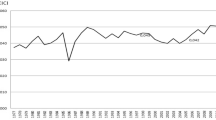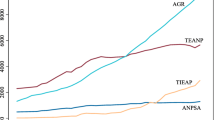Abstract
The directional distance function defined in a DEA type non-parametric framework provides a highly flexible structure for modelling producer behaviour in the presence of polluting emissions and environmental regulations. This article presents five models describing different “command and control” type policy measures as an economic one about nitrogen pollution of agricultural origin. These measures concern the management of the mandatory constraint on the spreading of organic manure and the investment in manure treatment facilities. The study also simulates the use of an economic instrument by enforcing the individual manure constraint at an aggregated level. Using individual and aggregated DEA models, this paper provides insights into the impact of individual and collective management of environmental policy instruments.
Similar content being viewed by others
References
Baumol, W. J., & Oates, W. (1988). The theory of environmental policy (2nd ed.). Cambridge: Cambridge University Press.
Brännlund, R., Chung, Y., Färe, R., & Grosskopf, S. (1998). Emissions trading and profitability: the Swedish pulp and paper industry. Environmental and Resource Economics, 12, 345–356.
Chambers, R. G., Chung, Y. H., & Färe, R. (1996). Benefit and distance functions. Journal of Economic Theory, 70, 407–419.
Charnes, A., Cooper, W. W., & Rhodes, E. (1978). Measuring the efficiency of decision making units. European Journal of Operational Research, 2, 429–444.
Chavas, J.-P., & Cox, T. L. (1999). A generalized Distance function and the analysis of production efficiency. University of Wisconsin-Madison, Staff paper 422.
Chung, Y. H., Färe, R., & Grosskopf, S. (1997). Productivity and undesirable outputs: a directional distance function approach. Journal of Environmental Management, 51, 229–240.
Färe, R., & Grosskopf, S. (2003). Non-parametric productivity analysis with undesirable outputs: comment. American Journal of Agricultural Economics, 85, 1070–1074.
Färe, R., & Grosskopf, S. (2004). New directions; efficiency and productivity. Dordrecht: Kluwer Academic.
Färe, R., & Grosskopf, S. (2009). A comment on weak disposability in nonparametric production analysis. American Journal of Agricultural Economics, 91(2), 535–538.
Färe, R., & Zelenyuk, V. (2003). On aggregated Farrell efficiencies. European Journal of Operational Research, 146, 616–620.
Färe, R., Grosskopf, S., & Lovell, C. A. K. (1985). The measurement of efficiency of production. Studies in productivity analysis. Dordrecht: Kluwer-Nijhoff Publishing.
Färe, R., Grosskopf, S., & Lovell, C. A. K. (1994). Production frontiers. Cambridge: Cambridge University Press.
Kuosmanen, T. L. (2005). Weak disposability in nonparametric production analysis with undesirable outputs. American Journal of Agricultural Economics, 87(4), 1077–1082.
Kuosmanen, T. L., Cherchye, L., & Sipiläinen, T. (2006). The law of one price in data envelopment analysis: restricting weight flexibility across firms. European Journal of Operational Research, 170(3), 735–757.
Kuosmanen, T. L., & Podinovski, V. (2009). Weak disposability in nonparametric production analysis: reply to Färe and Grosskopf. American Journal of Agricultural Economics, 91(2), 539–545.
Li, S. K., & Ng, Y. C. (1995). Measuring the productive efficiency of a group of firms. International Advances in Economic Research, 1(4), 377–390.
Luenberger, D. G. (1992). Benefit functions and duality. Journal of Mathematical Economics, 21, 461–481.
Luenberger, D. G. (1995). Microeconomic theory. New York: McGraw-Hill.
Montgomery, W. D. (1972). Markets in licences and efficient pollution control programs. Journal of Economic Theory, 5, 395–418.
OECD (2001). OECD national soil surface nitrogen balances—explanatory notes. Paris.
OECD (2003). Agriculture, trade and the environment, the pig sector. Paris.
Randall, A. (1972). Market solutions to externality problems: theory and practice. American Journal of Agricultural Economics, 54(2), 175–183.
Shephard, R. W. (1970). Theory of cost and production functions. Princeton: Princeton University Press.
Author information
Authors and Affiliations
Corresponding author
Additional information
Disclamer: The views expressed are purely those of the author and may not in any circumstances be regarded as stating as official position of the European Commission.
Rights and permissions
About this article
Cite this article
Piot-Lepetit, I. Technological externalities and environmental policy. Ann Oper Res 214, 31–48 (2014). https://doi.org/10.1007/s10479-010-0744-8
Published:
Issue Date:
DOI: https://doi.org/10.1007/s10479-010-0744-8




